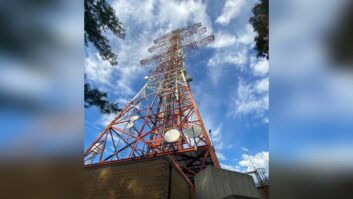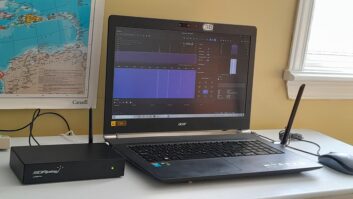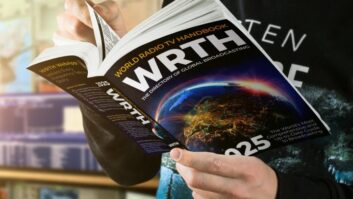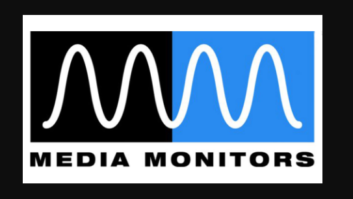Jeff White of Radio Miami International is president of the National Association of Shortwave Broadcasters and chaired the HFCC/ASBU B11 Conference Committee.

From left: Dowell Chow, president of Adventist World Radio; Horst Scholz, HFCC vice chairman; Lauren Libby, president of Trans World Radio; Oldrich Cip, HFCC chairman; and Jeff White, NASB president
The B11 Seasonal High-Frequency Coordination Conference took place in Dallas in September, organized by Continental Electronics and the National Association of Shortwave Broadcasters. In my mind, four significant points came out of the conference.
First was the fact that this was the first HFCC Conference to take place in the United States since the organization starting meeting in 1990. The HFCC, now in combination with the Arab States Broadcasting Union, meets twice each year in various countries; but it had never met in the U.S. In 2004, the NASB attempted to organize the A05 HFCC Conference in Miami, but Arab attendees were afraid that they would not be able to get visas, and the meeting was moved to Mexico City.
But the worlds of 2004 and today are different. This year the Arab countries and Iran supported the idea of having the HFCC in the U.S., and delegates attended from Algeria, Iran, Kuwait, Oman, Saudi Arabia and Tunisia. Now that the precedent has been set, hopefully some of the future meetings of the HFCC can take place in the U.S. again. Major thanks need to be expressed to the U.S. International Broadcasting Bureau and to Trans World Radio for their sponsorship of the meeting, along with that of Continental and the NASB.
The second significant fact about the Dallas conference was that the attendance was fairly similar to that of other recent HFCC meetings.
Many people thought that recent reductions in shortwave transmissions by some of the major international broadcasters would lead to a much-reduced attendance at the HFCC in Dallas. But some 100 delegates from 32 countries and 40 frequency management organizations around the world took part.
And it was obvious from the “collision lists” produced at the conference that even though a lot of stations have cut back on their shortwave frequencies recently, the HF bands are still quite crowded and it can still be difficult to find a clear frequency amidst the congestion of the shortwave bands.
‘Wake Up and Smell the Coffee’
As noted in Jeff White’s accompanying commentary, the High-Frequency Coordination Conference is expanding its scope. The following summary of the event is excerpted from an HFCC wrapup.
“There are some compelling reasons for doing this,” stated Chairman Oldrich Cip. “TV and radio organizations for home listeners and their unions are busy discussing the future of distribution of the media content and the use of new — mainly digital — technologies. We would like to become a forum for such debate in international broadcasting. … We believe that the debate should help develop a stable and effective system of content delivery and the synergy and cooperation between the old and new technologies.”
Lauren Libby, president of broadcaster Trans World Radio, told the September gathering: “Digital vs. traditional broadcast platforms are vying for audiences. Medium-wave vs. FM vs. shortwave … the list just gets bigger every day … We live in a world where change and competition for the media consumer is getting fiercer monthly.”
He exhorted delegates to “wake up and smell the coffee … It’s time to not do things ‘business as usual.’ Shortwave platforms will remain viable with new awareness campaigns and cross-promotion from the digital platform being employed. Quality content and quality delivery can help keep this multinational content delivery platform viable and appreciated. … Shortwave has a future … if we are willing to once again make it an attractive platform that is easily accessible to the general public that is cross-promoted from other media platforms.”
Charles Caudill, president of World Christian Broadcasting, which operates KNLS shortwave in Alaska, said his organization remains dedicated to shortwave and is planning to open a new station in Africa, Madagascar World Voice.
“That new station and the some $11 million we are spending on expansion is the reason I have been asked to speak to you today,” said Caudill. He said only 1 percent of people in Madagascar have access to the Internet. “Millions and millions do not have satellite receivers.” Areas like Siberia have little or no Internet or cell phone capability. Organizations that cut back shortwave hours, he said, “have just left a larger audience for World Christian Broadcasting.”
NASB member Adventist World Radio hosted a trip for delegates to Southwestern Adventist University in Keene, Texas. AWR has a network of shortwave, AM and FM stations, as well as podcasts and an LPFM. It recently upgraded its shortwave station KSDA in Guam. Attendees also visited Continental Electronics’ facilities, where they saw DRM transmitters under construction and witnessed a DRM exciter test.
Two new members were admitted to the HFCC: the Voice of Russia and Spaceline from Bulgaria.
Broader scope
The third important news item from Dallas was the decision by HFCC members to expand the scope of their organization.
Chairman Oldrich Cip made it clear that this will still be primarily a shortwave frequency coordination conference, but members voted to amend the articles of incorporation to expand the scope of the HFCC to include so-called “alternative delivery platforms” for international radio — things like the Internet, satellite, podcasts, local AM and FM radio relays, etc.
Chairman Cip suggested that future meetings might devote one day of the week-long conference to these alternative delivery methods. In part, this move is intended to counter the outflow of HFCC members who have ended or might end their HF broadcasts for budgetary or other reasons.
Finally, DRM — Digital Radio Mondiale — stood out as a highlight of this HFCC/ASBU Conference.
While some people had written off DRM as a “savior” of shortwave due to the lack of mass-market, low-priced DRM receivers, DRM Consortium Vice Chairman Ludo Maes showed up at the HFCC in Dallas a few days after helping to introduce some new low-cost (under $100) DRM receivers at the IBC in Amsterdam.
Maes showed three of these new receivers at a DRM presentation at the HFCC in Dallas, and he told delegates that more of these types of receivers are coming soon. He told the HFCC that the governments of Russia and India have decided to undertake major expansions of their domestic and international transmitter networks, all using the DRM system.
Adil Mina of Continental Electronics, the only manufacturer of high-powered shortwave transmitters in the United States, said that while many stations have reduced their shortwave transmissions, others are investing in new, modernized DRM-capable units. He said that all new orders for HF broadcast transmitters are requiring DRM capability.
So things are not as bleak as some would suggest in the shortwave industry. And if new low-cost digital receivers appear on the market in the near future, DRM could still spur a renaissance of shortwave radio. Some cynics will say “We’ve heard all this before,” but Adil Mina proclaimed that “Now our promises are coming close to reality.”







